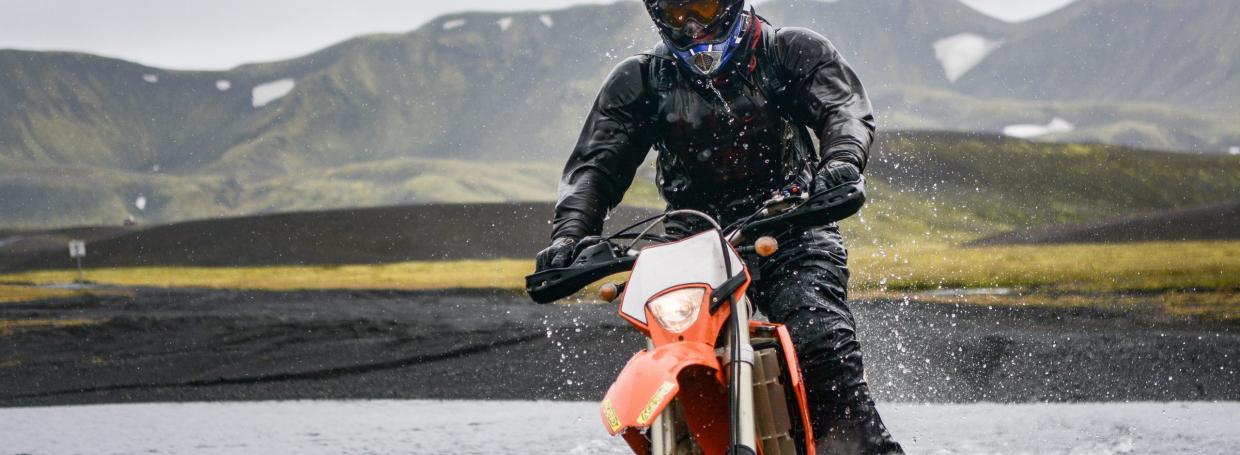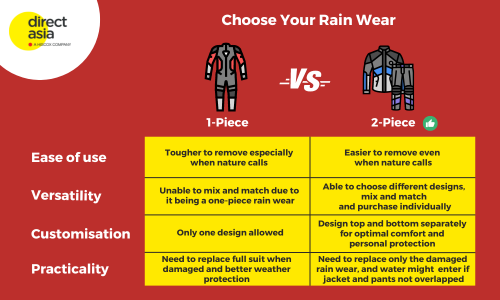Riding a Motorcycle in Singapore | Best Gear for Wet Weather

Best Motorcycle Rain Gear to Stay Safe in Wet Weather
Reading time: 9 mins
Open skies, open road, wind in your hair – motorcycle riding is a thrill any day and in any weather. Well, almost any weather. When the skies above turn dark and unleash their watery fury, your joyride can quickly turn into a damp disaster – and a dangerous one.
Even though Singapore is mostly known as a sunny isle, if you live here you’ll know that every other day can be peppered with raindrops; not to mention, the dreaded “monsoon months” towards the end of the year. Therefore, it’s best to be prepared at all times and invest in the right motorcycle gear against rain.
In this blog, we’ll discuss the best motorcycle rain gear you should invest in, the features you should look out for, and how to choose the right fit. The right investment will help you defy the rain gods and ensure you always reach your destination warm and dry and more importantly, safe!
Benefits of Good Motorcycle Rain Gear
But first things first, before we even get to purchasing anything, let’s consider why it’s even worth investing in motorcycle rainwear.

Top 4 Must-Have Motorcycle Gear Against Wet Weather
There are many different options when it comes to rain gear, but here are four waterproof motorcycle gear we think you should have in your arsenal when it comes to battling Singapore’s rainy weather:
- Motorcycle rain suit
- Motorcycle gloves
- Visor insert
- Motorcycle boots
Now, let’s dive into each of them and what’s most vital to consider when making your purchasing decisions.
1. Motorcycle Rain Suit
Your motorcycle rain suit will be your main armour against riding in the rain, so looking for one with the best protection is key.
Two-piece vs One-piece
Rain suits come in the one-piece option, much like a onesie with a full body length zipper, and a two-piece option, made up of a rain jacket and pants.
Many motorcycle riders in Singapore recommend a two-piece option over the one-piece for a variety of reasons:

Material choice
When selecting the best motorcycle rain gear, material choice is a crucial factor that determines its effectiveness and overall performance in wet conditions. What’s important to note is also that good rainwear is never made out of just one type of material, but a range of materials that each serve their own purpose.
Here are some key considerations to help you pick the right materials for your motorcycle rain gear:
Waterproofness: The primary requirement for rain gear is its ability to keep you dry. Look for materials that are explicitly designed to be waterproof or water-resistant. Common waterproof materials include nylon, polyester, and Gore-Tex®. These fabrics have a special coating or membrane that prevents water from penetrating the fabric while allowing moisture vapour to escape, keeping you dry and comfortable.
Top tip! “Weatherproof” and “waterproof” are not the same thing. Weatherproof gear will only protect you from light rain for a short period of time, but a truly waterproof motorcycle rain suit should have a moisture IP rating of 6 and above to protect you even when you’re riding in a heavy downpour.
The material itself is one thing, but don’t forget to pay attention to all the potential holes water can seep in through. Look for reinforced or heat-sealed seams and adjustable Velcro fasteners that help seal wrist and ankle openings, and ensure that the neck or collar area is also covered to prevent rain from getting in. Rainwear jackets with a hood are a good way to stay dry, and those fastened by Velcro are even better since they allow for easy removal if the rain stops and the sun comes back out.
Breathability: While it's important for rainwear to keep water out, it's equally vital for it to allow moisture and sweat to escape. Look for breathable poly-mesh linings that allow for good air circulation. This helps prevent the buildup of sweat and condensation inside your rain gear, enhancing your overall comfort and reducing the chances of overheating.
Flexibility: Your rain gear should allow for freedom of movement while riding. Look for materials that are flexible and offer a good range of motion. Avoid stiff or restrictive fabrics that may hinder your ability to manoeuvre comfortably. Stretch panels or gussets in critical areas, such as the shoulders, elbows, and knees, can enhance flexibility and ensure a better fit.
Reflectivity: Since visibility is crucial, especially in rainy conditions, always try to choose motorcycle gear with highly reflective elements.
Packability: Your rain suit will be stowed away on your motorcycle when it’s not raining, so you may also want to look for lightweight materials that can easily be folded or compressed into a compact size.
How to ensure a good fit
Size up: Don’t forget that your rain suit needs to be loose enough to fit over the clothing you’re already wearing. Sizing up at least one size bigger will allow more room for you to manoeuvre easily without feeling constricted. If the motorcycle rain jacket feels tight when your elbows are bent, your movement might be restricted, which is highly dangerous. And while it may look more flattering for your figure, your rain pants cannot afford to be too fitting as well, or it will cause difficulty climbing on and off your bike. Tight rainwear also increases chafing and abrasion, wear and tear, and will ultimately reduce the life of your investment.
Try it on: Where possible, try your rain suit on in a store, and put it through the test with a whole range of motions to ensure it is not restrictive in any way. It’s even better if you can try it out with the rest of your motorcycle gear such as helmet, gloves, and boots, to ensure compatibility with your existing riding gear.
Read reviews: If you’re purchasing online, make sure you read all the customer reviews, not only for quality and protectability, but also to see how different sizes fit other customers. If there are reviews that state “M was a good fit for me, I’m usually a UK 10” then it gives you a good guide for your own size reference.
2. Motorcycle Gloves
The choice to wear motorcycle gloves is quite a subjective one, as it depends on your personal comfort and gripability. If you have a better grip on your motorcycle’s handlebars without gloves, even despite a heavy downpour, then by all means, go glove-less! If, however, the cold from the rain affects your comfort level and control, then getting the right motorcycle gloves is a definite must.
Consider these three factors when looking to purchase a good pair of waterproof motorcycle gloves for optimal performance and protection:
- Traction: Control and handling is everything, especially in wet weather conditions. Gloves with grippy palms or fingers with features like silicone or rubberized grips can significantly enhance your handling.
- Fit: There’s a reason for the phrase “fits like a glove.” Finding the right fit of motorcycle gloves for you has to be exactly just like Prince Charming looking for his perfect-footed Cinderella. Your gloves cannot be too loose, as they need to fit snugly to ensure natural finger movement; and they also cannot not be too tight or restrictive, otherwise it can affect the accuracy or speed of your reaction. Make sure you test these before purchasing, or if buying online, make sure there is a return policy so you can always return a pair that doesn’t feel “perfect” for your hands.
- Insulation: Yes, you want the gloves to be thermally insulated to keep your hands warm even when riding in heavy rain, but you also don’t want them to feel stuffy and sweaty in Singapore’s humid weather if it’s just a slight drizzle. It’ll be up to you to find that sweet spot that feels just right. We promise we won’t judge if you’re waving your gloved hands in front of an air-conditioner in the shop!
3. Visor Insert
The problem with rainy weather in a humid climate like Singapore is, it makes the inside of your motorcycle helmet visor fog up easily. To prevent this from happening, you can purchase an anti-fogging visor insert. Riders say that once you have tried riding with one, you’ll never go back, so it is definitely worth the investment!
There are different sorts of visor inserts – some can be applied to the inside of your visor, while others need to be locked in place with a pin (commonly known as a Pinlock visor). To explore the options and find one that is the most compatible with your existing helmet, it’s best to check out local motorcycle shops and official dealers.
No matter what sort of visor insert you go for, make sure that your motorcycle helmet, visor and inserts are all up to the PSB Singapore Standard 9 : 2014 safety requirement.
4. Motorcycle Boots
It may be tempting to ride in the rain with slippers a.k.a. flip flops, but they simply scream “safety hazard”! Imagine riding on the PIE (expressway) and your flip flop flies off and hits another motorist in the face!
For your and other motorists’ safety and protection, wearing proper protective gear such as motorcycle boots is always better, whether or not it rains. Motorcycle riding boots also protect your ankles much more than any other type of motorcycle shoes.
Look for a pair of motorbike boots that are waterproof and breathable, high cut enough so your rain pants cover the top of them, and that come with anti-slip soles for better grip on damp roads.
Other than that, your choice in waterproof motorcycle boots will come down to style and design, so go ahead and purchase something that will make you feel stylish and comfortable!
Stay Dry & Stay Safe with The Right Motorcycle Rain Gear
Staying dry while motorcycle riding in wet weather isn’t just about avoiding discomfort or to prevent arriving at your 9am work meeting soaking wet.
In many cases, staying dry goes hand in hand with staying safe, which should always be top of mind whenever you get on that motorcycle.
Remember, safety should never be compromised, and while investing in high quality motorcycle rain gear comes with quite some expenditure, it is paramount to keeping your riding experience comfortable, and keeping you alive.
Purchasing them is one thing, though, the other is to never leave home without them! Make sure you stow your rainwear in your motorcycle compartment, or in a carry-on bag that you take along with you every time you ride.
We also recommend that you try to stop at a safe place to put on your rain gear – if it suddenly starts to pour while you’re riding – or ensure that you signal the other road users if you’re forced to stop by the shoulder of the highway.
But, no matter how prepared you can be with the right motorcycle gear on, accidents can still happen due to poor weather conditions and wet roads. So it's crucial to invest in good motorcycle insurance in the case of an unavoidable accident when it rains. DirectAsia provides three motorcycle insurance cover types to choose from, including a Comprehensive plan that covers your motorcycle if it gets damaged in a flood due to heavy rains. You can also add on Optional Benefits that includes 24-hour breakdown assistance in case your motorcycle gets impaired in the rain.

